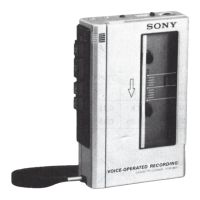www.SteamPoweredRadio.Com
I
•
I
•
Replacing chip components
All
chip c
omponents
should be
connected
and disconnect-
ed, using a tapered soldering iron [
temperature
of
the
iron
tip: less
than
280
°C
(536
°
F)]
, a pair
of
tweezers and braid-
ed wire.
Precautions
for
replacement
I.
Do
not disconnect the chip component forcefully.
Otherwise, the pattern may peel off.
2.
Never re-use a disconnected chip component. Dispose
of
all old chip components.
3.
To
protect the chip component, heating time for attach-
ing
the component should be within 3 seconds.
o Removing chip components
(1)
Removing solder
at
electrode
Remove
the
solder
at
the
electrode, using a
thin
braided wire. Do
not
remove
the
solder
of
the
part
(chip
component)
attached
adjacent
to
the
electrode.
Pattern
Soldering iron
(2)
Disconnecting chip components
Turn
the
tweezers with
the
soldering iron alternately
applied
to
both
electrodes, and
the
chip
component
will be disconnected. Take careful precautions while
disconnecting, because
if
the
chip
component
is force-
fully removed
the
land
may
peel
off
.
Never re-use a disc
onnected
chip c
omponent
.
TCM-SEV
(3)
Smoothing the soldered surface
After disconnecting
the
chip
component
, remove
the
solder
by
using a braided wire
to
sinooth
the
land
surface.
o Connecting chip components
The value
of
chip
components
is
not
displayed
on
the
main
body.
Take due precautions
to
avoid mixing new
chip
components
with
other
ones.
(1)
Applying solder
to
land
on
one side
Apply a
thin
layer
of
solder
to
the
land
on
one
side
where
the
chip
component
is
to
be connected. Too
much
solder may cause bridging.
(2)
Speedy soldering
Hold
the
chip
component
at
the
desired position,
using tweezers, and apply
the
soldering iron in
the
arrow-marked direction. To
protect
the
chip compo-
nent
, heating time should be within 3 seconds.
Land
Printed circuit
board
(3)
Speedy soldering
of
electrode on the other side
Solder
the
electrode on
the
other
side in
the
same
way as in
(2)
above .
- 3-

